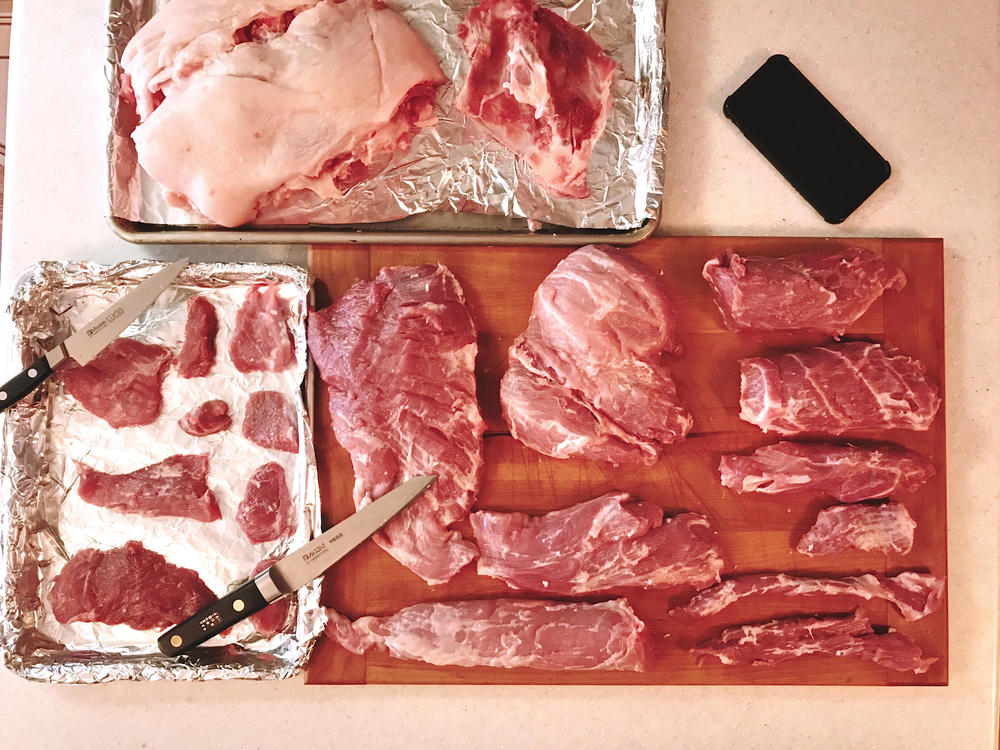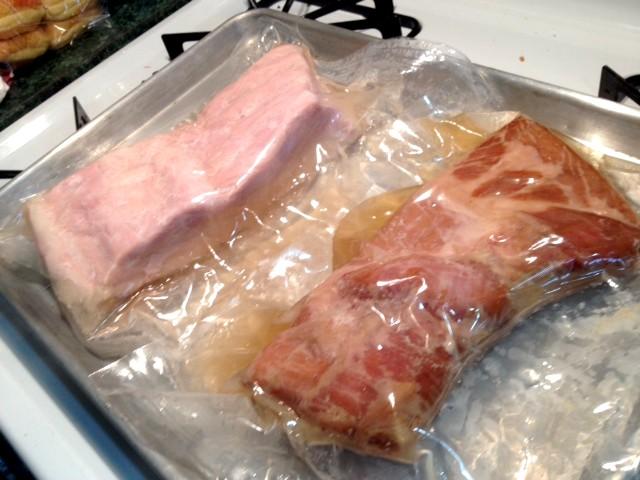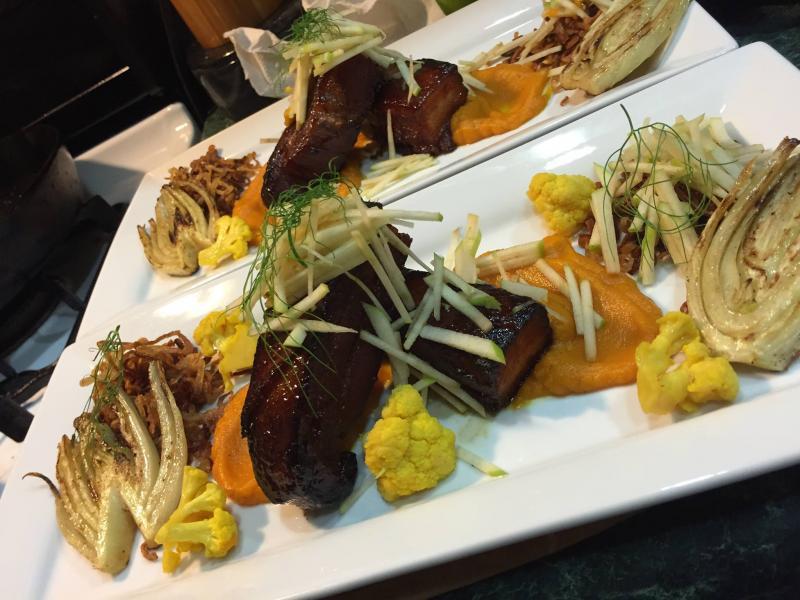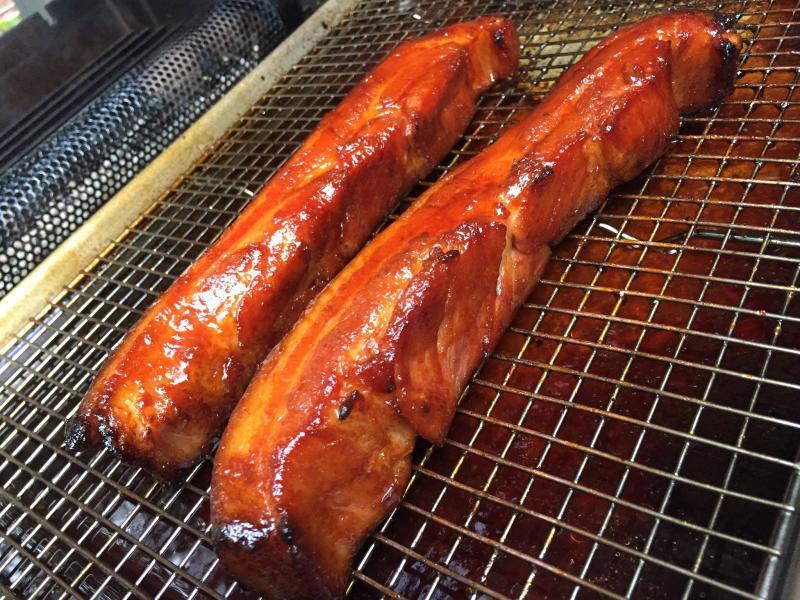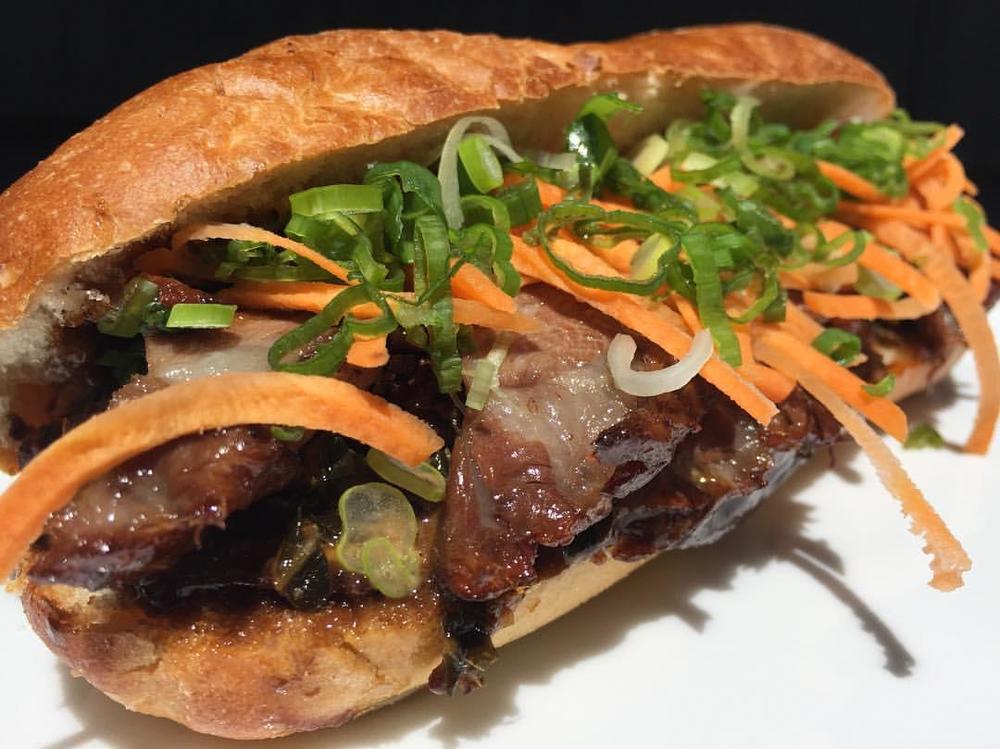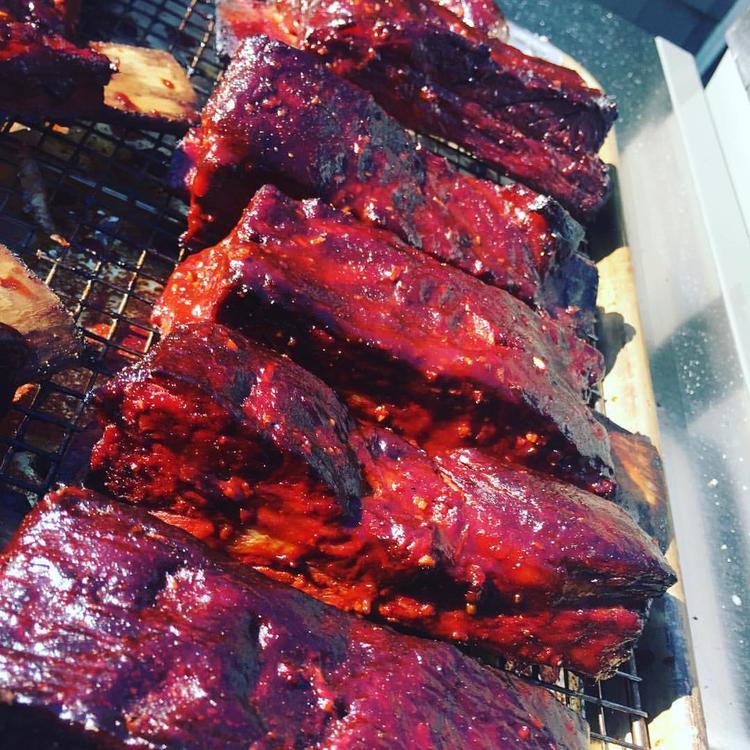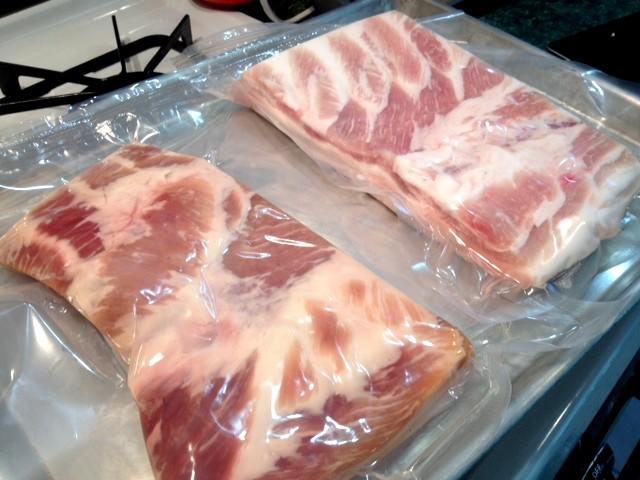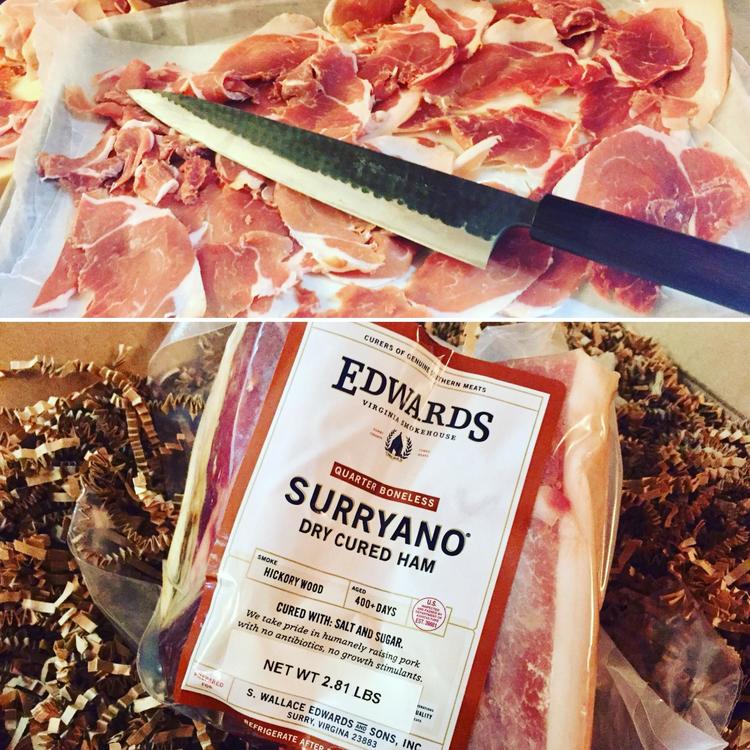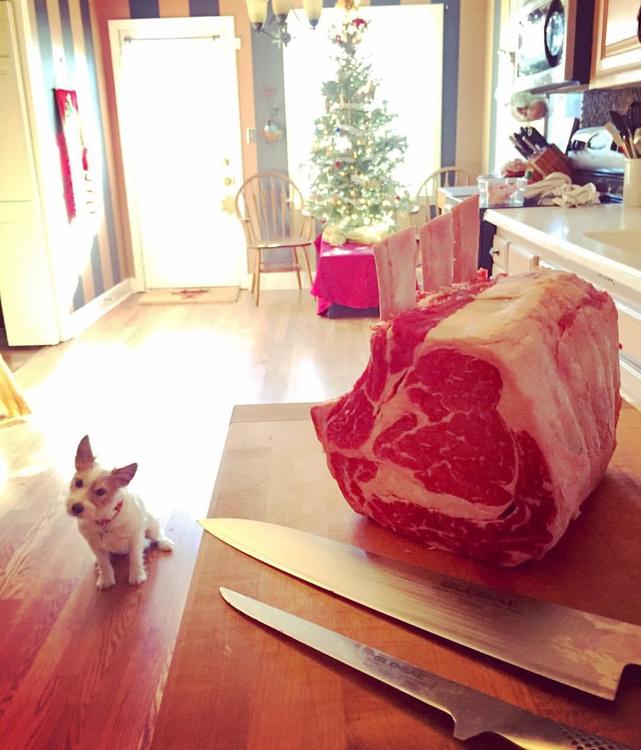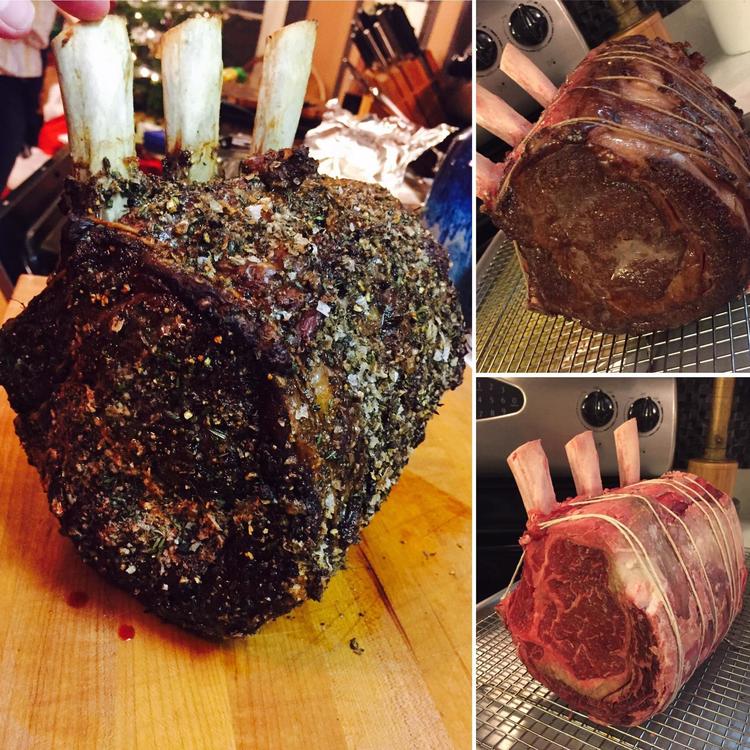-
Posts
1,807 -
Joined
-
Last visited
Content Type
Profiles
Forums
Store
Help Articles
Everything posted by btbyrd
-
The one exception is the Jose Andres style super-high-temp, essentially deep-fried egg that both browns and puffs as you cook it. But when done properly, the yolk still runs. I think browned yolk is what I find offensive. Overdeveloped sulphur notes.
-
Never in my life have I wanted to eat or cook browned egg.
-
Wheat-free, rice-based "ramen" noodles are an abomination. They might be tasty in their own right, but they ain't ramen. That dish looks delicious, by the way.
-
To a certain extent, I want the meat to dry out. At least, the meat on the surface. One of the best things about many long-smoked products is the textural difference between the crunchy exterior and the tender interior. But you're right, humidity can be an issue -- especially if your final therm is going to be like an hour or more. In those cases, I'll put the meat on a rack over a sheet pan of ice, which I believe MC recommended. My smoker is a grill, and it doesn't really go lower than 225F, so having the extra ice in there works as both a heat sink and as a source of humidity. But honestly, I don't worry about it for most things. I brine all my pork and poultry, so it stays moist enough, and I've never found the interior of beef to really dry out during the final smoking process. (And some of that is brined anyway). The ChefSteps "smokerless smoked brisket" recipe finishes the brisket in a low oven for 3-4 hours to form the bark; I do the same for as lightly shorter period in a slightly hotter oven/grill with actual smoke. This is an excellent point. Smoke is a flavoring agent, and it's possible to use too much -- especially on delicate product. Double smoke could definitely be overkill for delicate items.
-
My thought is that there maybe some volatile flavor compound(s) that gets driven off or changed by the roasting process or by simmering in an open pot, but that this can't happen in the IP. If all you're doing is throwing raw turkey bits in a sealed cooking vessel, there's no where for those aroma/flavor compounds to go. Maybe they end up as "turkey fat flavor" in your stock. That's pure conjecture, of course, but a thought. I make virtually all of my stock in a pressure cooker these days, and I almost always roast the bones first. Roasting creates a flavor that I prefer for most applications (unless you need a delicate stock, which can happen) and it mostly removes the need for blanching the bones/meat, since the roasting process helps denature a lot of the nasty bits that'd float to the top of your stockpot. If you neither blanched nor roasted, that might be the cause of the issue. Or maybe you just got a funkier turkey, or its fat oxidized as you stored the carcass, or some such thing. I doubt it's the Instant Pot.
-
I wet cured both of these pork bellies. In the first image, the belly on the left has been cold smoked, while the one on the right has only been cured. The difference in color is much more dramatic after they came out of the bath. I don't have the "after" shot after they got rethermed on the smoker, but the final color and flavor on the double smoked belly was superior. I've found this to be true of pork and beef ribs as well. So now I just do the double smoke as a general practice whenever possible. Here's some double smoked SV meats on the smoker getting that final crust. First up, some glazed pork belly. On the plate: And some short ribs: On the sandwich: It was a mashup of BBQ styles. Texas meets Korea meets the bahn mi. Black garlic aioli, collard green kimchi, carrot and daikon shreds. If anyone cares, I use an Amazen tube smoker on my Weber grill. It burns pellets, but doesn't really generate heat of its own. In the winter, I'll cold smoke things on the grill without having the heat on. It's good to do large batches if possible, and then freeze for later. I'll also turn my grill on low and use it as a proper hot smoker. Dollar for dollar, the $25 or $30 I spent on the Amazen tube smoker are probably the best money I've spent for cooking equipment. And I've spent a lot of money on cooking equipment.
-
I combine smoke with SV frequently. The best strategy is to smoke twice. I'll generally do a cold smoke on the meat prior to putting it in the bag, then cook it SV, and chill it down. Final retherm on the smoker until you can't resist anymore. I've done side by side comparisons with pork belly smoked before, after, and before and after. Before and after was the winner. Smoke particles are small enough to permeate plastic. If you smoke before hand, your cooking liquid is going to smell like smoke. On the second day, you will smell it from across the kitchen. But the particles that remain in the bag continue to develop as they cook, or so Chris Young said once upon a time. You get a more muted smoke flavor, but it has an added complexity. I do the final retherm smoke to add back that "fresh campfire" element that gets lost to the SV water. It also helps dehydrate the exterior and develop a proper bark (which SV alone would never give you). I have a Smoking Gun, and while it's fun, it is no substitute for actual smoke in an actual hot box as far as the final smoke is concerned. You can do it on a small scale with some items -- quail and other small birds take to that treatment well, for obvious reasons. Also, the SVE guys are goons.
-
Conventionally braised meat browns better and tastes better than meat that's been cooked to death in a bag. And conventional braises evaporate, so the liquid part is slowly reducing and concentrating in flavor over the course of the cook. The braising liquid from a beef roast in the oven is heavenly. The bag liquid from SV braises is borderline disgusting. When you braise meat in the oven, it comes along with a delicious free sauce. When you braise meat in the bag, it never browns up and you have to really work to create a sauce from the cooking liquids.
-
There are many good ways to clean cast iron and carbon steel, but none of them can begin to compare to the ease and joy of cleaning a Teflon coated pan. And that is the only reason I own Teflon. If you're worried that your cast iron or carbon steel has thick layers of irremovable crud on it, scour the pan with a paper towel and a cup of kosher salt. Really grind the crystals in there. Then scrub with sponge and soapy water, rinse clean, and do a round of reseasoning. There's no need to avoid soap with CI and CS. There is a need to know how to season. Things I've never had to bother about with a Teflon pan.
-
FWIW, I use my nonstick pans almost exclusively for eggs cooked at lower temperatures, which includes scrambled eggs. For the life of me, those will always wreck a carbon steel or cast iron pan -- gunk stuck everywhere, a cleaning nightmare. And please don't suggest that I'm not using enough fat. Even using the pretty-darn-good heat control settings on my Vollrath Mirage induction burner, scrambled eggs would stick no matter what technique I tried. Super fast, high temp, big-curd, fluffy eggs are a different matter. Fried eggs are another matter as well. The only other time I find them useful is if I'm going to be tossing something with a syurpy or starchy sauce over higher heat. Burnt on stirfry sugar: no bueno. But for everything else, including fish, I prefer my Dartos. Cast iron has mostly been relegated to cornbread duty and the occasional batch of nachos.
-
I've tried them before and should give them another try, as it's been a while. I remember them being good, but somewhat thinner than I was used to. I'll give them another try sometime soon. I'm definitely going to try the broth you mentioned. Looks very good judging by the ingredient list and the enthusiastic reviews. I've been meaning to try the "baking soda/spaghetti" alkali noodle trick to see how that works, but I fear my sensitivity to soapy alkali flavors may pose problems.
-
The texture of fresh (or pre-packaged, non-dried) ramen is different, and to my mind better, than fried instant noodles. But they're a pain in the ass to make yourself and they're not widely available commercially. I was an advocate of fresh Sun Noodles for a short time, but was rather quickly turned off by the ridiculous amount of riboflaven they add to the noodles to create the yellow color. It's so much that it turns the cooking water yellow. And you can taste it. Noodles that taste like vitamins? Horrible. It's like everything bad about enriched flour or rice, but turned up to 11. I went back to instant packets. Sun Noodles makes the noodles for many of the top ramen shops, and I'm sure they have formulations available that aren't vitamin B-2 bombs. In fact, I'm sure I've eaten some of those noodles. If you could buy fresh, non-Ribo-roided-out Sun Noodles at the local grocery, I'd be very happy. The noodles would be perfect if they weren't dyed with freaking vitamins. I'm keen to try these fresh-ish noodles from Hakubaru, which use annatto for color. I'd prefer that companies didn't dye their noodles at all, but if you're going to do it... annatto > riboflaven.
-
Everyone says not to spend a lot of money on nonstick pans, and they're right. It's going to crap out eventually, much sooner than your untreated cookware would even dream of failing. But inexpensive nonstick pans are prone to be both thin and lightweight. This causes the pans to eat unevenly and increases the risk of scorching. It also makes it more likely that you're going to burn off your magic nonstick chemical coating and give yourself the cancer. (Or whatever.) I found this to be true of many well-regarded pans, including the T-Fal that Cook's Illustrated and ATK rated highly. I accidentally scorched that one on an induction burner that couldn't properly detect the pan temperature because it weighed so little that the sensor couldn't register how superheated the pan was getting. My bad? The T-Fal is okay and the price is right, but it feels lightweight and cheap and it kind of cooks like it's lightweight and cheap. Probably because it is lightweight and cheap. I think those can be virtues, but I generally prefer to cook with something that has more mass and doesn't require thermal babysitting to avoid meltdown. Which sent me questing for some thicker nonstick pans. Now I use the Anolon Nouvelle Copper nonstick pans, which I bought largely on the basis of this review. You can get good deals on a bundle that includes the 8 and 10 inch pans for around $40. Well worth the money. They have just over 5mm of cladding, using layers of stainless, aluminum, and copper (though there's not terribly much copper, which is to be expected for the price). They heat up slowly and evenly, and the mass of the pan is sufficient to store up thermal energy for proper searing at medium-high temps. My only complaint is that the edges are so gently flared that the pans actually feel smaller than they are. The bottom of the 10" pan is roughly 7.5" in diameter, for example. But the good news is that the pans perform very well. The handles are nice. The prices are very reasonable. 4.5 out of 5 stars. I have also heard good things about the Ikea pans. ChefSteps uses a lot of those (or did at one point). But I believe they're on the thinner side.
-
SV short ribs - 48hr @ 140F or 72hr @ 130F. I wouldn't bother cooking short ribs hotter or faster than that with a circulator. It's a waste. If you want braised short ribs, braise short ribs. Or use a pressure cooker. Either would produce better results than sous vide short ribs boiled to death at 185F or whatever.
-
I’ve never understood the smaller curved blades like the ulu, even for things like herbs. I was gifted an ulu and used it once. And then I went back to my actual knives. Maybe if you’re scraping pelts... Mezzalunas at least seem useful for cutting pizza.
-
-
Whenever you order from Father's, Benton's, Edwards, or whatever.... you're going to eat it on shipping. So order a bunch of stuff. My standard Father's order is 12 hocks, 8 pounds of bacon, and a pound of prosciutto slices. I have similar standard orders elsewhere. Vacuum-sealed ham and hocks will keep for pretty much ever in the freezer, or for months in your fridge. Bacon is the only thing you need to worry about eating quickly. I've found that the fat in country bacon is liable to oxidize and become rancid, and I'm super sensitive to rancidity in bacon. So I make an effort to plow through the bacon quickly when I get it. When tomato season hits, order all the bacons from all these companies. Or really, why wait?
-
Officially, I refer to pressure cooked Father's ham hock stock as "Hot Ham Water." It's so watery... and yet there's a smack of ham to it. Emphasis on the smack.
-
I do a cold kombu infusion overnight, in part because that's how Morimoto does it in his book and in part because that's how my lazy ass likes to do it. 10g kombu per liter of water. Strain the next day and pop that into the pressure cooker with the hocks. I forget how long I go, but it really doesn't matter. It's at least an hour; I'm thinking that I go 90 mins in the IP, but you could shoot for an hour and see how you like it. If you use kombu infused water instead of regular water, the ham kinda ends up with a dashi-like flavor which can be better or worse depending on what you're going for. The ham stock is good plain or "dashi-fied." Either way, there will be a ton of flavorful stock and the hock meat will still be lip-smacking delicious. It's almost impossible to overcook. I keep meaning to try pulling the muscles into individual threads and deep frying them a la ChefSteps's Crispy Ham Threads. I've done that with flank steak for Modernist Cuisine's crispy beef thread salad. It was a labor of love, but freaking tasty. It takes about a million years to pull those threads... Crispy ham action starts at around 52 seconds in: I believe the quote that @lindag was referencing was about Benton's, not Father's. Benton's doesn't have hocks on their website, but I'd be surprised if they didn't offer them. I know that they sell "bacon ends" over the phone (they're not on the website) so they probably have hocks as well.
-
Their hocks are legend. At least in my house. I pressure cook them to death in some water and then pull them apart by hand once they’re cool. Throw those tasty bits in anything. Even after more than an hour in the pressure cooker, the shredded hock meat is still intensely flavored. I use Father’s ham stock sort of like David Chang used Benton’s bacon dashi at Momofuku; a mother stock that can season just about anything. It makes fantastic greens, beans, grits, gravy... it’s a great poaching medium too. A great addition to soups and stews. I use their “bacon seasoning” to make bacon dashi, actually. It’s basically the fattier trim from the belly before they portion and slice the bacon. That’s the best use I’ve found for it. And beans. And if you ever need to render a bunch of bacon fat (grind or blend it first). Father’s bacon is reliably the smokiest I’ve found, so even the trimmings bring a lot of flavor.
-
Yep. I was waiting a long time for them to recover from that tragedy. But as soon as they were back... it was Surryano time! I tried a lot of knives to get thin slices. You want a blade that’s long and thin. My sujihiki (above) was too thick to do a great job; I ended up going with a granton edged carving knife, which performed the best out of all my knives.
-
Here are some of the best purveyors of country ham that I know of. Most have been mentioned already, but let's keep the list growing. I'd love to discover more producers. Benton's Country Hams (TN) Broadbent Hams (KY) Calhoun Country Hams (VA) S. Wallace Edwards and Sons (VA) Father's Country Hams (KY) Johnson County Hams (NC) Col. Bill Newsom's Country Hams (KY)
-
How do you want to serve it? If you're going to eat it raw, I'd spend a few extra bucks for the Edwards boneless quarter Surryano. It's some tasty business, even if it is like $30 a pound. But it can hold its own with European hams in the same price range. A slightly cheaper, pre-sliced, but just-as-delicious option in that regard is Father's proscuitto. This, along with the Surryano, are my two favorite American hams (that I've tasted thus far). If you're wanting to serve classic cooked country ham "family style" (and not just fried slices or something), the Edwards petite cooked ham is a good option, in large part because of how it's been trimmed. And it's pre-cooked and ready to go. It's probably the easiest, high-quality introduction to cooked country ham. I will say that if you're a fan of smoke and funk, Father's makes about the best ham I can imagine in those regards. The Father's ham hocks are worth their weight in gold, but you can get 6 for $15. Vacuum sealed country hams do not require refrigeration prior to being opened, but you should probably do it anyway if you're going to store for extended periods.
-
The Blumenthal low oven method is fundamentally unsafe, as the meat will not get out of the danger zone in sufficient time given evaporative cooling. Also, home ovens are garbage when it comes to maintaining constant low heat. Chris Young got into it with Heston about the food safety of that recipe when they were developing it. The technique was offered prior to the advent of inexpensive immersion circulators. Anyway, my current preferred method is pre-sear -> sv -> 550F+ convection oven sear. I've also gotten a good looking crust using the ChefSteps "egg white herb salt foam thing" method. But herb crust or no, the sear -> SV -> sear combo is hard to beat in terms of predictability and deliciousness. This is from the Christmas before last. Whenever I trim meat or french bones, my best friend keeps me company. Anyway, here's the same roast \raw, tied, and fridge-dried (lower right), still raw but pre-seared in a Darto No. 27 carbon steel pan (top right), and the final product after 8 hours at 135F and a hot blast in the oven with the herb crust. Big flakes of Maldon are sexy on a roast, you guys. I'll also add that if you french bones or do a lot of home butchery, you should consider investing in a hankotsu knife (not pictured above). They are pretty magical. They glide around bones and are designed to scrape.
- 176 replies
-
- 10
-

-




